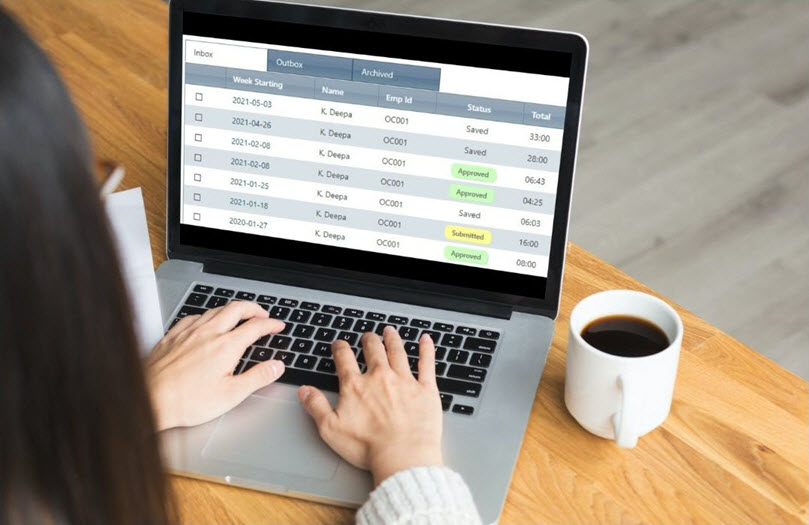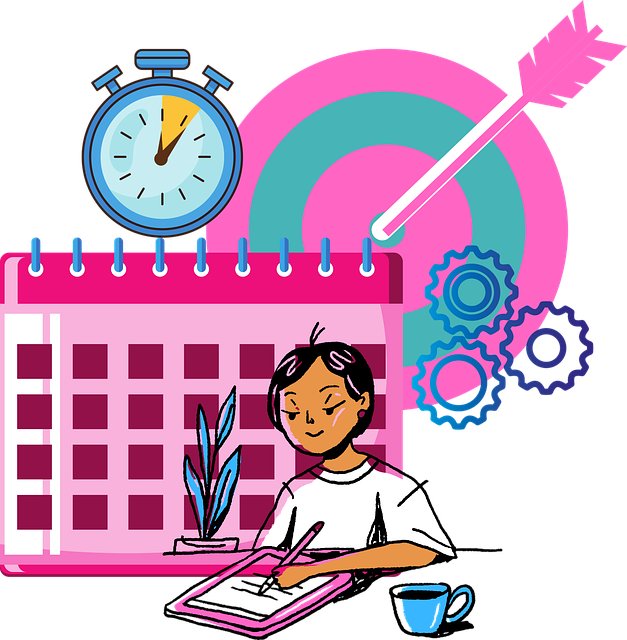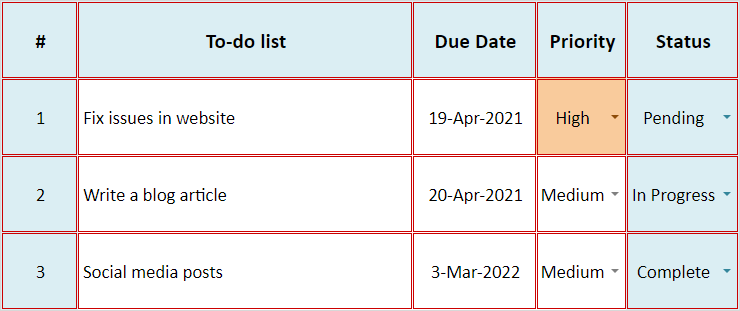What is Productivity?
Productivity is simply getting the most out of your time and effort. It’s about achieving your goals efficiently, whether at work or in your personal life.

Here are some key points to remember:
- Productivity is measured by comparing your output (what you accomplish) to your input (the time and effort you put in).
- Being productive means achieving your goals efficiently and effectively.
Want to measure your productivity? We have a free template that can help! Just enter your data and see how productive you are. Click on the link given below:
Free Template to measure Employee Productivity
We have great tips for you if you need help boosting your productivity.
Tools & Tips to Improve Productivity:
Following these actionable tools and strategies will not only improve your productivity, but also equip you with a well organized system for managing and organizing your tasks, projects, and time.
1. A Step-by-step Guide to tackle your To-Do List:
Managing a long to-do list can be overwhelming. Here’s a guide to breaking down your work and boost your productivity:
- List & Organize:
-
- Gather your projects: Write down all active projects you’re working on.
- Use templates: Free online templates can help you list and organize tasks efficiently.
- Or go digital: Consider online task managers for ultimate organization.
- Break Down & Prioritize:
-
- Create tasks: For each project, list specific tasks needed for completion.
- Sub-tasks: Break down large tasks into manageable, smaller steps.
- Prioritize ruthlessly: Use a system (e.g., urgency, importance) to rank tasks.
- Delegate & Set Deadlines:
-
- Assign tasks: Distribute tasks among team members based on skills and workload.
- Set realistic deadlines: Give yourself and your team achievable completion times.
- Track & Take Action:
-
- Track time: Use a timer or tool to monitor time spent on each task.
- Identify delays: Watch for tasks exceeding deadlines and take corrective action.
- Flexibility is key: Be prepared to adjust plans and priorities as needed.
Bonus Tip: Break down big tasks into sub-tasks to make them feel less daunting.
These steps will help you reach your goals without getting stressed. Regularly update your list, prioritize tasks, and track your progress to stay on top of your workload.
2. Prioritize Your Tasks with the 80/20 Rule:
Effective task prioritization is crucial for achieving your goals in today’s fast-paced world. With countless tasks piling up it is hard to determine which task to do first. Here’s where the 80/20 rule, known as the Pareto Principle, shines.
What is the 80/20 Rule?
The 80/20 rule, also known as the Pareto principle, states that 80% of the results come from 20% of the causes. In the context of your project, 80% of your project outcomes will be achieved by focusing on just 20% of your tasks.
How to Apply the 80/20 Rule to Your Project:
- Identify all tasks: Make a comprehensive list of all tasks associated with your project.
- Evaluate each task: Analyze each task based on its importance and urgency. Importance refers to how much the task contributes to your project goals, while urgency refers to the deadline for completing the task.
- Identify the 20%: Using your analysis, identify the 20% of tasks contributing to 80% of your project outcomes. These will be your high-priority tasks.
- Focus and prioritize: Once you have identified your high-priority tasks, focus your time and energy on completing them. This will ensure you make the most efficient use of your resources and move your project forward quickly.
Benefits of Applying the 80/20 Rule:
- Increased productivity: By focusing on your most important tasks, you will significantly increase your overall productivity.
- Reduced stress: By eliminating feeling overwhelmed and focusing on the most impactful tasks, you will naturally experience reduced stress levels.
- Improved motivation: Completing your high-priority tasks gives you a sense of accomplishment, which can motivate you to keep moving forward.
- Better resource allocation: By focusing on the tasks with the most significant impact, you can ensure you allocate the resources more efficiently.
- Timely project completion: By prioritizing your tasks effectively, you can increase your chances of completing your project on time and within budget.
Remember:
- The 80/20 rule is a guideline, not a hard and fast rule.
- Sometimes, you need to adjust your priorities based on specific circumstances.
- It’s essential to revisit your priorities regularly as your project progresses, ensuring that you are always focusing on the most critical tasks.
- You can apply the 80/20 rule to all areas of your life, not just project management.
- By implementing the 80/20 rule, you can prioritize your tasks effectively, increase your productivity, and achieve your project goals with greater ease.
You can use the matrix given below to prioritize your tasks.
| Urgency | Important | Not Important |
| Urgent | Do First (20% of tasks) | Delegate or Eliminate |
| Not Urgent | Schedule (20% of tasks) | Eliminate or Reduce |
To use the above matrix, click on the link given below:
Matrix to implement the 80/20 rule
3. How to Automate Repetitive Tasks:
We all face those repetitive tasks that consume our time and energy, leaving us drained . These tasks, while necessary, can be tedious and hinder our productivity. But automation offers a powerful solution for handling repetitive tasks, freeing you to focus on what truly matters.

Here are just a few examples of how marketing automation can help you reclaim your time:
- Automate welcome emails: When a new customer signs up, send them a personalized welcome email series introducing them to your brand and highlighting your offerings. Businesses can do this automatically using CRM software, saving you the time and effort of manually sending individual emails.
- Schedule follow-up calls: Set up a call list to schedule regular follow-ups with your leads and customers.
- Create tasks and events: With new customers signing up, you can create a task to set up a demo or automate an event to schedule a meeting.
- Schedule reports and track progress: Regularly receiving scheduled reports will help track your projects’ performance and measure your results.
This will help you identify what’s working and what’s not so you can make informed decisions about allocating your resources.
4. Tidy up your Workspace:
In today’s work-from-home reality, maintaining a clean and organized workspace is crucial for productivity and well-being. Here’s how you can achieve a work environment that supports your success:
Creating Your Home Office Haven:
- Dedicated Space: Designate a specific area in your home as your workspace. This helps establish boundaries between work and personal life, promoting focus and mental clarity.
- Ergonomic Essentials: Invest in a comfortable desk and chair that support good posture and prevent unnecessary strain.
- Natural Light & Fresh Air: Position your workspace near a window to maximize natural light exposure and access fresh air, which enhances alertness and mood.
- Cleanliness is Key: Maintain a clean and organized workspace. Declutter regularly, keep surfaces tidy and organize your tools and materials.

Benefits of a Clean Workspace:
Studies like the one by the University of Arizona have shown that employees in clean and organized environments are up to 15% more productive. This is because:
- Clutter reduces focus: A messy environment can be visually distracting and make it difficult to concentrate on tasks.
- Organization saves time: A well-organized workspace reduces the time spent searching for misplaced items, boosting efficiency.
- Cleanliness promotes well-being: A clean space can contribute to a sense of calm and order, reducing stress and promoting overall well-being.
- Clean Workspace, Happy Mind: By prioritizing a clean and organized workspace, you create an environment that supports your productivity, well-being, and overall happiness.
5. Overcome Distractions and Gain your Focus:
As the saying goes, “You can’t do big things if you’re distracted by small things.”
In today’s technology-driven world, distractions constantly threaten our productivity. From social media notifications to chatty colleagues, these distractions can significantly diminish our ability to focus and complete tasks efficiently.
Here are some common culprits that steal our attention:
- Social media: The endless scroll of feeds and notifications can be irresistible, but they can significantly diminish our focus.
- Phone notifications: Constant pings and alerts from our phones can be incredibly distracting, even if we don’t look at them directly.
- Interruptions: Colleagues dropping by, unexpected calls, and unplanned meetings can disrupt our workflow and make it difficult to get back on track.
- Email overload: A flooded inbox can be overwhelming, leading to constant checking and context switching, hindering focus.
- Personal to-do list: The pressure of looming errands or chores at home can create anxiety and make it difficult to immerse ourselves in work fully.

As per the study, Frequent interruptions disrupt the flow of work, making it difficult for employees to maintain focus and complete tasks efficiently.
Gloria Mark’s research indicates that after an interruption, it can take up to 23 minutes to regain concentration and return to the original task fully. As a result, these disruptions lead to decreased productivity, increased stress, and a higher likelihood of errors.
Overcoming the Distractions:
Fortunately, we can fight back and reclaim our focus with a few simple strategies:
- Deep focus sessions: Set aside dedicated periods where you eliminate distractions by silencing your phone, turning off notifications, and closing unnecessary tabs.
- Noise-canceling headphones: Block out the noise and create a calmer environment conducive to focused work.
- Scheduled breaks: Plan specific times for checking emails, taking phone calls, and grabbing coffee. This helps limit interruptions and maintain focus during dedicated work periods.
- Communication: Inform colleagues about your deep focus sessions to minimize unnecessary interruptions.
- Prioritization: Organize your to-do list and tackle the most important tasks during your most focused hours.
- Use website blockers: to restrict access to social media sites for a particular period and allow you to focus on work.
Remember:
By consciously managing distractions and prioritizing focused work periods, you can dramatically improve your productivity, reduce stress, and achieve your goals more efficiently.
6. Ditch Multitasking:
Multitasking is a big productivity killer. Studies, including one by Forbes, reveal that multitasking can reduce your performance by as much as 40% and make you more prone to errors.
Here’s why:
- Shifting focus: Switching between tasks takes time and mental energy, disrupting your flow and hindering your ability to concentrate fully.
- Increased errors: Multitasking leads to divided attention, making you more prone to mistakes and oversights.
- Reduced quality: When you attempt to do several things at once, the quality of each task suffers.
Focus is the Key:
Instead of multitasking, focus on single task for better results. By focusing on one thing at a time, you can experience several benefits:
- Enhanced Productivity: By avoiding context switching and maximizing your focus, you can complete tasks significantly faster and more accurately.
- Improved Quality: With your undivided attention, you can produce higher-quality work, ensuring more significant impact and satisfaction.
- Reduced Stress: By removing the pressure of juggling multiple tasks, you can feel calmer and more in control, leading to better mental well-being.
- Boosted Creativity: When you can fully immerse yourself in a task, your mind has the space to explore new ideas and develop innovative solutions.
Remember:
Focusing on a single task does not mean working slower but working smarter. By focusing on one task at a time, you can achieve more with less stress and produce higher-quality work.
7. Time tracking:
“Master your time and boost productivity with effective time tracking.”
Staying on top of your time is crucial for any project or task. It reveals where your minutes and hours go, highlighting areas for improvement.
Knowing how long each task takes helps you identify:
- Time bottlenecks: Are you spending too much time on specific tasks? Streamlining workflows, delegating, or seeking additional resources can free up time.
- Focus areas: Where can you sharpen your concentration to be more efficient? Identifying distractions and implementing focus techniques can significantly impact your output.
- Resource needs: Does a particular task require additional training, tools, or software? Investing in the right resources can save you time and frustration in the long run.

Effortless time tracking:
Go digital with various free online timesheet software options. These platforms allow you to:
- Track time effortlessly: Simply start and stop timers for each task or project.
- Gain insights: Generate reports to visualize your time usage and identify patterns.
- Boost collaboration: Share timesheets and track team progress on projects.
Alternatives for the online software:
Suppose online tools aren’t your cup of tea, fear not! Here are some alternative time-tracking methods:
- Free timesheet templates: Download or create simple templates to manually track your projects, tasks, and working hours.
- Pomodoro Technique: This method utilizes a timer to break down work into 25-minute intervals with short breaks in between. It’s a fantastic way to stay focused and avoid burnout.
Remember:
- Knowing where your time goes is the first step to optimizing it.
- Experiment with different time-tracking methods to find what works best for you.
Managing your time efficiently will help you achieve your goals faster.
8. How Breaks Recharge your Mind and Body?
Remember Anne Lamott’s wise words – “Almost everything will work if you unplug it for a few minutes… including you.“
Sometimes we work so hard that we often forget the crucial importance of taking breaks. Taking breaks will help our brains rejuvenate to stay sharp and efficient.
Science backs this up:
Studies show that taking short breaks throughout the day can boost productivity by up to 9%. That’s two 15-minute breaks, adding nearly three extra hours of productive work per week!
Taking breaks offer many benefits:
- They relieve stress and anxiety, allowing us to return to tasks with a calmer, clearer mind.
- They spark creativity by letting our brains wander and make new connections.
- They prevent burnout, that dreaded state of exhaustion and disengagement.
- They contribute to overall well-being by promoting relaxation and mental health.

So, how often should you break?
The ideal duration and frequency depend on your work style and preferences. However, a good rule of thumb is to step away every 30-50 minutes for a short 10-15 minute break.
Some inspiring ideas for your power breaks:
- Step into nature: A short walk in the park or even gazing out the window at some greenery can improve your mood and focus.
- Connect with loved ones: A quick call to a friend, a chat with colleagues, or a playful interaction with your pet can bring a smile and a fresh perspective.
- Move your body: A quick 10-minute yoga routine or light stretches can energize and boost your mood.
- Power nap: If you have the time and privacy, a short nap can work wonders for your cognitive function and alertness.
- Unplug and recharge: Read a book, listen to music, or sit quietly and let your mind wander.
Remember, taking breaks isn’t a sign of laziness; it’s a sign of self-care and a commitment to long-term productivity and well-being.
9. Discover Your Most Productive Time
We all have that magic hour when our minds are full of energy, creativity, and focus. It’s your peak performance zone; finding it is the key to unlocking your maximum productivity.
What is the best time of the day when you can focus better? Morning, mid-day or late in the evenings?
Some folks are like the early birds, chirping with productivity at sunrise. They conquer emails and tackle complex problems before the world wakes up. Others are more productive after lunch. And then there are the night owls, their minds buzz with creative energy after sunrise.
Identify Your Prime Time:
- Pay attention to your energy levels: When are you most alert and focused? Do you naturally gravitate towards early mornings, midday hustles, or quiet evenings?
- Track your accomplishments: Notice when you complete tasks efficiently and with high quality. Are there specific times of day when your work shines?
- Experiment and adjust: Don’t be afraid to try different schedules and see what works best for you. Some people thrive on a consistent routine, while others benefit from a more fluid approach.
Optimize Your Peak Time:
- Schedule your most challenging tasks for your peak hours: This is when you’ll have the mental stamina and focus to tackle those brain-busters.
- Minimize distractions: Eliminate unnecessary notifications, silence your phone, and create a calm environment conducive to deep work.
- Fuel your focus: Nourish your body and mind with healthy snacks and drinks that keep your energy levels steady.
- Embrace movement: Short breaks for a quick walk or stretch can refresh your mind and return you to your peak state.
Remember, your peak time isn’t just about completing the tasks. It’s about maximizing your potential, getting engaged in your work with deep focus.
Bonus Tip: Use time-tracking apps or productivity tools to monitor your energy levels and identify your most productive periods throughout the day.
10. Prioritize Physical Activity for Better Performance:
Prioritizing regular physical activity plays a critical role in optimizing professional performance. Working out isn’t just good for your body, it makes you smarter, happier, and even helps you get more done!
The Science of Enhanced Performance:
A Briston University study of 200 employees across diverse organizations revealed the positive impact of physical activity on work performance. Employees evaluated their productivity on days with and without exercise, demonstrating:
- 21% improvement in concentration
- 22% increase in task completion on time
- 25% reduction in unscheduled breaks
- 41% boost in work motivation

How it works?
- Exercise triggers the release of endorphins, reducing stress and anxiety and promoting a positive mental state.
- Increased blood flow to the brain enhances cognitive functions like focus, memory, and problem-solving.
- Improved sleep quality, facilitated by exercise, leads to better cognitive performance and energy levels the following day.
Integrating Exercise into Your Professional Life:
- Prioritize physical activity within your weekly schedule, incorporating activities you enjoy, whether a brisk walk, team sports, or a gym session.
- Start with moderate intensity and duration, gradually increasing as your fitness improves.
- Utilize short exercise breaks throughout the workday to maintain energy levels and combat sedentary fatigue.
- Investing in your physical well-being is an investment in your professional success. By prioritizing regular exercise, you’ll be equipped to tackle challenges with greater focus, motivation, and efficiency.
Bonus Tip: Consider incorporating fitness trackers or activity monitors to track your progress and stay motivated.
Remember, a healthy body is the foundation for a productive mind.
11. Recognizing and Addressing Burnout:
Have you ever felt like you’re running on empty, no matter how hard you try? Sometimes, even your best efforts feel like they’re falling short. You might find yourself constantly tired, stressed, and unable to focus.
These could be signs of burnout, a state of emotional, physical, and mental exhaustion caused by prolonged or excessive stress.
Are you at risk?
- 30% of people report experiencing burnout due to unrealistic demands and expectations.
- It’s estimated to cost businesses $1 trillion annually in lost productivity due to depression and anxiety.

Identifying the Signs:
- Constant fatigue and exhaustion
- Cynicism and negativity towards work
- Reduced motivation and productivity
- Difficulty concentrating and remembering things
- Feelings of helplessness and hopelessness
Take a self-check:
Instead of pushing through, consider a burnout assessment template. Identifying the root cause can help you take appropriate steps toward recovery.
Consequences of ignoring burnout:
- Briefly discuss the negative impacts of ignoring burnout, including:
- Decreased productivity and performance
- Increased risk of physical and mental health issues
- Strained relationships and difficulty maintaining work-life balance
Remember:
Addressing burnout isn’t a weakness; it’s a sign of self-care and prioritizing your well-being.
- Talk to trusted friends, family, or a therapist. Their guidance and perspective can be invaluable.
- Prioritize self-care activities like exercise, relaxation, and sleep
- Set realistic boundaries and learn to say no
- Communicate openly with your manager about workload and expectations
- Creating a healthy work-life balance is crucial for long-term productivity and overall well-being. Don’t wait for burnout to hit – prioritize your health and seek support if needed.
Bonus Tip: Explore mindfulness practices like meditation or deep breathing to manage stress and improve focus.
By making these changes, you can prevent burnout and build a sustainable, productive life for yourself.
12. Ending Your Day with Planning:
Imagine waking up energized and ready to manage your day with a clear roadmap for work.
Why must you jot down your thoughts and plan your new day?
- Clearing your mind before bed reduces anxiety and improves sleep, leading to better focus and energy the next day.
- Visualizing your goals and tasks strengthens your commitment and makes them feel more achievable.
How to plan your day?
- Spend 5-10 minutes at the end of your day jotting down key tasks, ideas, and priorities for tomorrow.
- Review your previous day’s accomplishments to celebrate wins and identify areas for improvement.
- Set realistic goals and deadlines for the next day, ensuring they are specific, measurable, attainable, relevant, and time-bound (SMART).

- Use a traditional pen-and-paper journal, a digital app, or even a simple whiteboard.
- Find what works best for you! Some prefer detailed to-do lists, while others benefit from mind maps or bullet points.
Give this 5-minute ritual a try and see how it transforms your mornings and boosts your productivity!
13. Invest in Your Productivity and Skills:
Want to crush your goals and unlock your full potential?
Why Upgrading yourself is the key!
- Staying ahead in today’s dynamic work environment requires continuous learning.
- Investing in your skills is an investment in your future. The more you learn, the more you earn and the more fulfilling your career can be.

This weekend, invest in your future by:
- Sharpen your skills: Dive into a relevant leadership, communication, or project management book. Udemy or Skillshare offers a wealth of online courses to fit your needs.
- Expand your knowledge: Explore new topics related to your industry or personal interests. Attend a local workshop on data analysis or creative writing.
- Challenge yourself: Volunteer for a new project at work or take on a personal challenge like learning a new language or running a 5K.
- Networking: Network with professionals at industry events or join a local meetup group.
- Volunteer: Volunteer at a non-profit, gaining new skills while giving back to the community.
- Nourish your mind and body: Don’t neglect self-care! Practice mindfulness through meditation, exercise, or simply spend time in nature.
Remember, even minor upgrades add up to significant results. Invest in yourself this weekend and watch your productivity and skills soar!
Small changes can lead to big results. Start implementing these tips today and unlock your full potential! Productivity isn’t about doing more; it’s about doing the right things better. Choose quality over quantity and watch your success unfold.
Other Recommended Articles:
- Productivity
- Effective Time Management Tips
- Addressing Employee Burnout
- The Importance of Time-tracking for businesses of all sizes
Deepa Kapoor is an online writer for small businesses. She loves to write on the advancements of new technologies and how it affects our lives. She always explores ways to make small businesses more profitable. When not writing, she enjoys reading books and cooking exotic traditional food.


